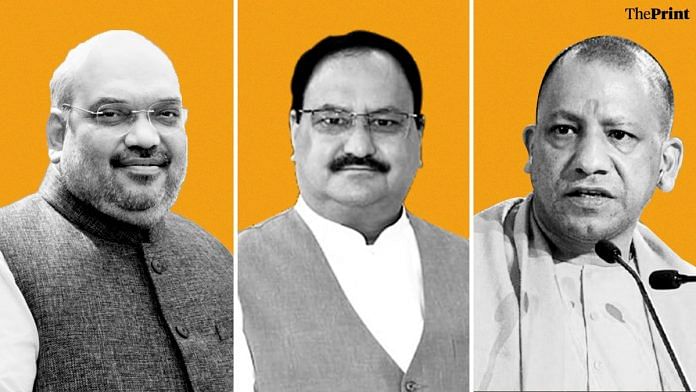New Delhi: For the Greater Hyderabad Municipal Corporation election, the BJP has deployed ‘heavy artillery’ for campaigning — Home Minister Amit Shah, BJP National President J.P. Nadda, Uttar Pradesh Chief Minister Yogi Adityanath, and Maharashtra’s former chief minister Devendra Fadnavis among others.
In episode 627 of ThePrint’s ‘Cut The Clutter’, Editor-in-Chief Shekhar Gupta explains how these elections are necessary to understand BJP’s approach to politics and power. He decodes what Home Minister Amit Shah calls the BJP’s P-2-P (Panchayat to Parliament) approach to politics.
Amid all these big leaders, “BJP MP Tejasvi Surya is already there lighting up fires like he always does,” said Gupta.
Recently, Surya compared AIMIM’s President Asaduddin Owaisi with Muhammad Ali Jinnah. He also accused Owaisi of ‘Islami-sing’ Hyderabad.
Also read: Behind BJP’s grand Hyderabad campaign is a 2017 plan by Amit Shah
Amit Shah’s P-to-P approach
Gupta argued that what is happening during the municipal election in Hyderabad gives us a good insight into the ‘BJP’s mind’.
“Superpowers fight their battles small and far away from their shores where they have little to lose. BJP approaches politics with that kind of mindset,” he explained.
Gupta recalled a speech that Shah gave in 2017 at the party’s national executive meeting in Bhubaneswar, Odisha. Shah had then said that the BJP is yet to attain its peak and will only do so when it has chief ministers in all states and members everywhere, from Panchayat to Parliament.
“This is the P-to-P approach that the BJP has, which Amit Shah started, where you first start with Panchayats and build up strength to reach the Parliament. I may, in fact, add another P to it, which means Panchayat to Parliament to power,” Gupta said.
The P-to-P approach applies especially to states where the BJP is not powerful or didn’t exist until recently, Gupta said.
Congress, an easy target
In national politics, a trend has been noticed wherein wherever the Congress is an incumbent, the BJP has a very good chance of winning. In the last parliamentary elections in 2019, the BJP recorded winning margins of at least 92 per cent against the Congress.
“For the BJP, Congress is the easiest party to target,” Gupta said.
However, there are some states where Congress is not the most popular, but the second most popular. “It is in those states that BJP is now reaching out, because they know their easiest competition to defeat is the Congress,” he added.
This is what happened in the Northeastern state of Tripura, where the Congress had been strong but now BJP has entered by way of votes. The BJP also did so in Odisha and now Telangana, Gupta said.
Also read: KCR announces Delhi-like ‘free water’ scheme for Hyderabad ahead of local body polls
Trends in Telangana and Odisha
In the 2018 assembly elections in Telangana, BJP got one seat with 7 per cent of the vote. In comparison, the Congress, which was in partnership with TDP, got 19 seats. So, Congress got 28.43 per cent of the vote.
Whereas, in the 2019 Lok Sabha elections, Congress got three seats with 29.79 per cent of the vote vote in Telangana and the BJP got four seats with more than 19 per cent of the vote.
“So, that is how the big turnaround happens in the BJP’s fortunes. It starts in the assembly, doesn’t do well, builds strength, By the time Lok Sabha comes, it’s done better than the Congress,” Gupta said.
The BJP also got the prestigious seat of Nizamabad, where they were up against Telangana Rashtra Samiti leader K. Chandrasekhar Rao’s daughter Kalvakuntla Kavitha.
In Odisha, Zila Parishad elections are based on party affiliations. In 2012, the BJP had just won 36 seats out of the 853 seats. The Biju Janata Dal won 651, whereas the Congress won 128.
But in the next five years in 2017, the situation “reversed”. BJP won 297 seats, while BJD got 473 seats. The Congress was just left with 16.
“This means that the BJP has become much more comfortable with a credible number two, even at the local bodies level. Whereas, Congress has now become an insignificant number three,” Gupta said.
Also read: BJP inroads clear in Tamil Nadu but Amit Shah’s ‘Midas touch’ faces tough test in 2021
BJP’s tactic of polarisation
Gupta noted that Hyderabad has one of the largest Muslim populations for a city in India, about 44 per cent people are Muslim while 52 per cent are Hindu.
The Muslim vote is controlled by AIMIM’s Owaisi, who is in partnership with Telangana Chief Minister KCR, Gupta said.
“This campaign in Hyderabad gives BJP a window into the larger Telangana politics by saying that KCR is sold out to a Muslim party and he will now give away power over Hyderabad to AIMIM, to Owaisi,” Gupta said.
He explained that BJP will use its ‘favourite tactic’ of polarisation for this purpose.
“To understand India’s politics, you have to understand BJP and its approach to politics and power. To understand BJP’s approach to politics and power, you have to understand Hyderabad’s Municipal polls because it gives you insight into how BJP plays its politics,” Gupta concluded.
Watch the latest episode of CTC here:



